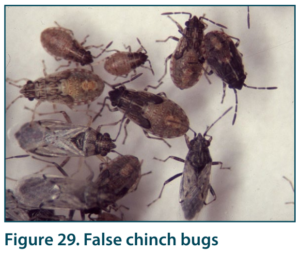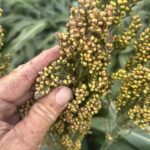Early last week, I received reports of false chinch bugs in sorghum fields around Corpus Christi. Several fields there were treated to prevent yield losses.
Today, we found a field south of Victoria with alarming numbers of false chinch bugs in some of the sorghum heads. When you shake a sorghum head into the bucket and find 200+ bugs, it can be a bit concerning.
After scouting around the field, I determined the field was averaging somewhere between 20 and 50 false chinch bugs per head. It is difficult to get a good estimate in the field because one head may have well over 100 bugs and the next head may not have any. And the bugs don’t sit sill for you to count them accurately, so they are estimated.
The false chinch bug (Nysius raphanus) resembles the chinch bug but is uniformly gray to brown (Fig. 29). False chinch bugs are 1/10 inch long. Large numbers of these bugs occasionally migrate from wild hosts, such as wild mustard, to sorghum. However, these insects usually concentrate in small areas of a field. Sample for false chinch bugs using the beat bucket method. The action level for false chinch bug is 140 bugs per grain head when infestation begins at the milk stage of grain development until hard dough.
Insecticidal control recommendations are primarily pyrethroid insecticides.
More information:
